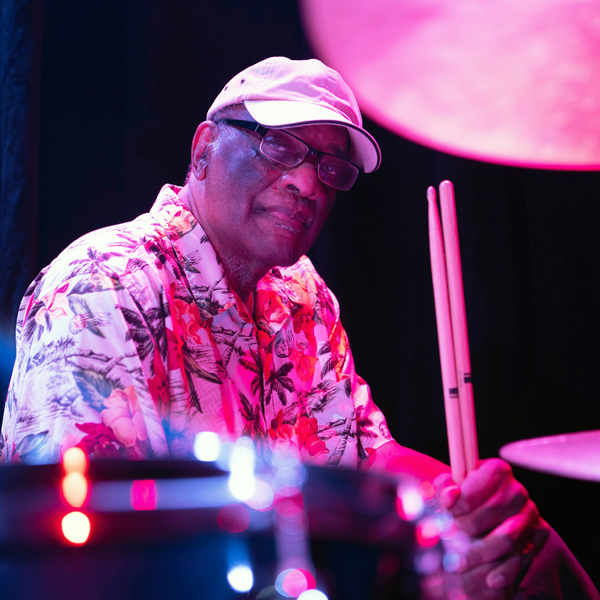February 3, 2023
Acclaimed composer and multi-instrumentalist Joe Chambers brings together a global cast of talent on Dance Kobina, a joyous and ruminative gesture from the drummer and vibraphone master. His third release for Blue Note Records — and sonic complement to 2021’s Samba de Maracatu — Dance Kobina spotlights Chambers’ original compositions, explores new music, and delivers a fresh, intimate treatment of enduring tunes — each selection heavily informed or subtly influenced by AfroCuban guaguancó. “To me, all these pieces are connected,” says Chambers, “in many ways.”
Recording sessions in New York and Montréal provided alternate contexts for the artists to experiment orchestrally, stretching out around textural and harmonic ideas as well as rhythmic possibilities. But the intrinsic beauty of Dance Kobina reflects all the nuanced ways each piece relates to its counterparts. “What makes a great suite great? The relationship between the various pieces,” says Chambers, who also serves as producer and arranger for the recording.
Chambers developed a profound understanding of these relationships over the course of his legendary career. Though he released his first Blue Note album as a leader in 1998, he’d been in the stable for decades, recording on pivotal 1960s sessions with Bobby Hutcherson, Wayne Shorter, Joe Henderson, Freddie Hubbard, Andrew Hill, and Sam Rivers. His resume expands outside the label, including associations with Eric Dolphy, Tommy Flanagan, Art Farmer, Charles Mingus, Sonny Rollins, and Max Roach.
Chambers’ legacy of treating repertoire as vessels for spontaneity emerges with renewed energy on Dance Kobina. His New York band comprises trio-mates Rick Germanson on piano and Mark Lewandowski on bass, as well as Cuban percussion master Emilio Valdés Cortes and Marvin Carter on alto saxophone. Montréal personnel includes Caoilainn Power on alto saxophone; pianist Andrés Vial — who called the session and serves as co-producer on several tracks; Michael Davidson on vibraphone; Ira Coleman on bass; and Congolese artist Elli Miller Maboungou on percussion. “Andrés’ date was percussion centered,” says Chambers. “It was so striking to me, and I thought, I’d like to take some of these songs and put them on this stuff we did in New York.”
Finding the through line within the New York repertoire and material they recorded in Montréal would develop an arc and create many byways on Dance Kobina. Opening and resolving on the New York Trio, the album interprets rhythms and patterns that have been part of Chambers’ expression for many years. “I’ve always been into AfroCuban, rumba, guaguancó — that sound,” he says. “It’s in my blood. I listened to that music when I was little, growing up outside Philly. I’ve always been attracted to the Cuban guaguancó as well as jazz.” Some repertoire selections engage guaguancó and related traditions explicitly; others, implicitly. But the feeling persists throughout the recording.
Chambers helped memorialize “This Is New” generations ago on Chick Corea’s 1966 recording Tones for Joan’s Bones. On Dance Kobina, the tune serves as an introduction not only to the New York trio, but to an interactive elasticity that buoys each composition. “It’s a tune I’ve played a thousand times,” says Chambers, “in New York playing with cats in different bands. It’s a great tune.” Album title track, Vial’s composition “Dance Kobina,” transmits an energetic bembe groove and sets the record’s exploratory tone. “This is the one that really stood out to me at the session,” says Chambers. “I liked it as soon as I heard it, so we put it in song form.” Davidson leaves space for the artists to respond and develop ideas around his melodic shapes before Vial takes the conversational lead and Chambers’ fluid reflexes layer the groove. After they recorded the title-less song in Montréal, Chambers proffered “Dance Kobina” as a kind of homage to Maboungou’s contributions: In Lingala, a Bantu language spoken in the Congo, kobina means “to dance.”
Carter captures a new angle of the iconic melody for “Ruth,” a Chambers original that was previously recorded on his 1998 Blue Note release Mirrors. The piece serves as the second movement of Chambers’ Moving Pictures Suite commissioned by the Jazz at Lincoln Center Orchestra as a concerto for drums and orchestra. Mood-casting further develops on “Caravanserai,” a fast rumba that features Chambers’ plumes of lyrical agility weaving through a syncopated netting from Cortes. Named for Montréal, Vial’s “City of Saints” provides a gesture of small moments and blossoming rhythmic nuance. Coleman sets up a foundational pulse in 5 for the artists to reflect, engage and play against throughout the composition. “This piece was kind of in the spirit of [Miles Davis’] Sanctuary,” says Chambers. Interlocking rub pervades the poly-metered piece “Gazelle Suite,” another of Chambers’ compositions. “This is a piece that has a lot of possibilities,” says Chambers.
“Intermezzo” signals an ethereal moment on Dance Kobina. The short, textural interlude features Chambers’ instrumental versatility and, out of time, echoes harmonic ideas that lead into the loose and vital rumba of Joe Henderson’s “Power to the People.” Concluding with the New York trio on “Moon Dancer,” Dance Kobina returns to a lyrical context and far subtler influence of guaguancó. “These pieces,” says Chambers, “they’re different, but they connect. And I hope the people will feel that connection when they listen.”







